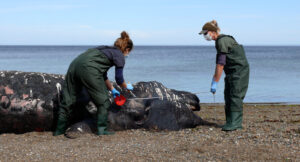The Southern Right Whale Health Monitoring Program aims to study the health of whales that die in Península Valdés and surrounding areas to learn about their health, understand the causes of mortality, and identify potential threats, both natural and of human origin.
The gentle slopes of the beaches and the large tidal ranges in the gulfs of Península Valdés favor the finding of stranded dead whales on the coasts. This provides the opportunity to assess the health status of this population through the performance of necropsies (post-mortem studies) and the collection of biomedical samples.
Through forensic examinations, the goal is to identify possible risks to the health of the whales and assess their susceptibility to diseases, contaminants, and other harmful agents, thus contributing to their conservation through management strategies.
How does the Program work?
Upon the registration or notification of a stranding of a Southern Right Whale on the coasts of Península Valdés and surrounding areas, the field team led by veterinarian Julieta Rodríguez Melgarejo goes to the site.
Before starting the necropsy or forensic examination, a thorough external examination is carried out in search of scars, wounds, and external evidence of the cause of death, whether natural (e.g. predation) or by human actions (e.g. cuts from boat propellers or injuries from nets or ropes). Photographs and measurements of the dead whales are taken, and the body condition, age class (calves, adults, juveniles), and geographic location of the stranding are recorded. All this information is entered into a database that has been kept updated since the beginning of the Program.

Tissue and organ samples are obtained from each whale to investigate the effects of various factors, such as seagull attacks, infectious diseases, biotoxins, plastics, and contaminants, among others. Physiological indicators such as stress hormones, nutritional status, diet, and genetics are also analyzed. Evidence of the direct effects of human activities, such as injuries from entanglements in ropes, fishing nets, or cuts from boat propellers, is documented as well.
Seagull Attacks
A notable variable measured in Península Valdés when dead whales are stranded on the beach with their backs visible is the presence, number, and size of lesions caused by seagulls prior to their death.
This provides information to monitor the effect that seagull attacks have on the health of whales over the years.
 Gull Attack Marks[/caption>
Gull Attack Marks[/caption>
Results of Sustained Work
Since the beginning of the Program, researchers have studied over 900 whales and collected thousands of samples for various scientific studies.
Sustained work over the years has led to the detection of significant variations in the number of dead whales between seasons, including exceptional mortalities of calves and adults in some years, something that would have otherwise gone unnoticed without official statistics.
In some cases, the recorded numbers were so high that they drew the attention of the international scientific community. For example, between 2007-2013, 554 whales died with an average of 75 lost calves per year. In 2012, 113 calves born that season died, and in 2022, 28 adult whales died. Both events represent the highest recorded mortality rates in a year for the species worldwide. Unusual mortality events are a cause for concern as they can be indicators of environmental changes possibly derived from human actions that contribute to the death of whales.
Source: ballenas.org.ar
Have you checked out our YouTube channel yet? Subscribe now!



